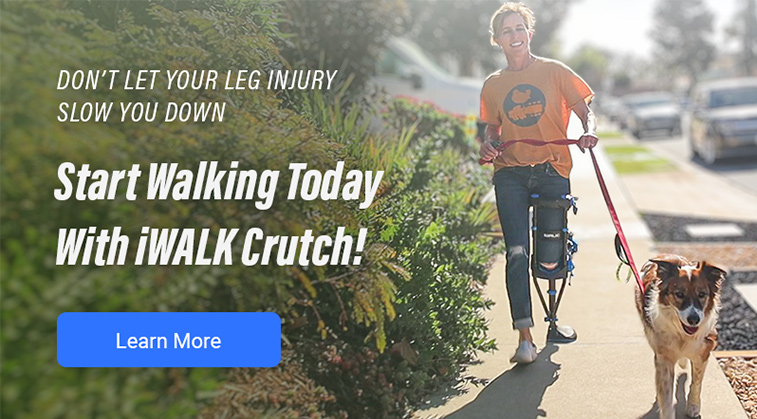Crutches Resource Center
Everything you need to know about crutches
All About Crutches
Types, How to Use, and Alternatives
More than 100 million pairs of crutches are produced in the world each year. So, it’s likely that at some point you or someone you know will have to use them.
This is easier said than done because, let’s face it, crutches suck.
Crutches are mainly used for lower leg injuries or illnesses, which require non-weight bearing. After a few days of battling with them, you may be tempted to cheat – but it’s really important that you don’t.
Instead, read our guide to crutches to help you get your mobility back. Learn about the different types available and get tips on how to use crutches. You can even read about the history of crutches – after all, you’re not going anywhere for a while. So, sit back and learn everything you need to know about one of the world’s most hated devices.
Reasons To Use Crutches
Most people use non-weight bearing crutches when they need to keep weight off an injured leg, so they can heal and get back to full mobility. Non-weight bearing crutches can be used for both short and long-term mobility assistance and can help you support your weight when you’re unable to do so on your own.
Injuries that require crutches include:
- Achilles tendon ruptures
- Broken ankles
- Foot fractures
- Stress fractures
- Tibia fractures
- Pulled muscles
- Sprains
- ACL injuries
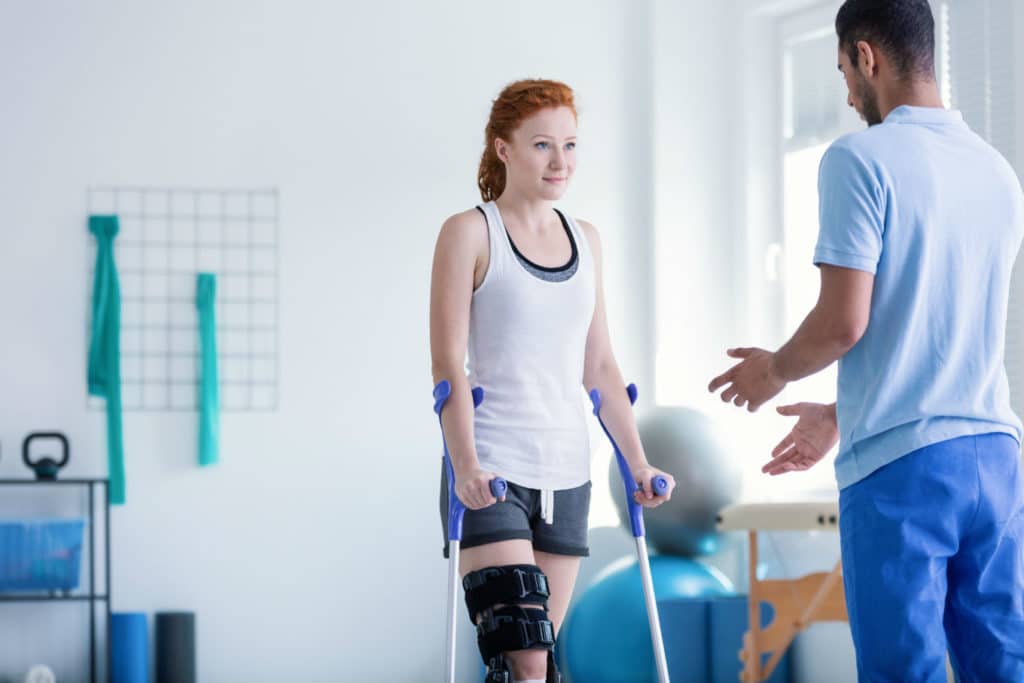
Most people use non-weight bearing crutches when they need to keep weight off an injured leg, so they can heal and get back to full mobility. Non-weight bearing crutches can be used for both short and long-term mobility assistance and can help you support your weight when you’re unable to do so on your own.
Types of Crutches
When we hear the word crutches, most of us immediately think of the conventional underarm type. These have been around for thousands of years – and they haven’t got much better during that time.
Luckily, these days there are some more options to choose from.
The Underarm Crutch (Axillia/Axillary Crutch)

Underarm crutches are the most common in the US. They’re also known as axillary crutches and are the usual type given to patients following a lower leg injury. In fact, most people assume they’re the only option available.
They can be used for all leg injuries and help you to move around without putting any weight on your leg, giving your injury time to heal.
However, they restrict the use of your arms, so you’ll need help to perform everyday tasks and chores. They can be painful and cause your underarms, wrists and hands to become sore. Plus, unless you’re as fit as Usain Bolt, they’re also pretty exhausting to use.
There’s also the potential of axillary nerve damage if used incorrectly or for longer time frames. You will lose the use of your hands and arms when using underarm crutches, so getting through your daily routine will require assistance.
How to Use: The best way to use these crutches is to stand straight with the crutches slightly in front of your feet and the crutch pad 1–2 inches below your armpits. Swing your legs forward between your crutches, landing on your good leg, then repeat.
Price: $12-$49
Forearm Crutch (Lofstrand Crutches)
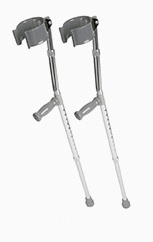
These are more common in Europe and Canada, and function much like underarm crutches. The difference is that forearm crutches have an open cuff that grips your arms while you’re using them. They are also known as elbow crutches.
Forearm crutches are often used for longer term injuries and illnesses. They use more upper body strength than underarm crutches, but they give you more control over your movement. They tend to be easier to use on uneven terrain and stairs.
The downsides are the same as underarm crutches. They are inconvenient as you can’t use your hands for anything else. They can be painful to use, particularly on your hands. And they can be extremely tiring, even after short periods of time.
How to Use: Using a forearm crutch is similar to using an underarm crutch. Using your uninjured leg and crutches for support, swing your weight forward between your crutches and land on your good leg. Make sure the cuff of the forearm crutch is 1–1.5 inches below your elbow
Price: $25-$150
Hands-Free Crutch
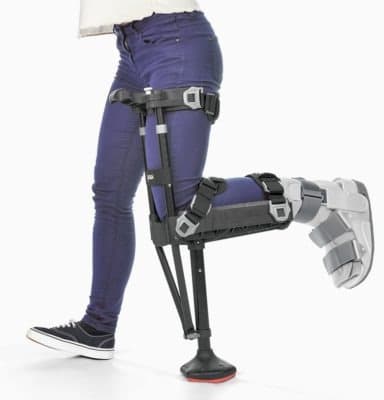
A hands-free crutch, known as the iWALK Crutch, functions like a hi-tech peg leg. It allows you to get your mobility back and go about your day to day life.
You kneel on a padded platform, keeping your injured leg safely elevated behind you. The crutch becomes a temporary prosthetic lower leg.
The iWALK Crutch has a number of benefits. Because you retain the use of both your hands, it gives you a lot more freedom. People who use it can go to work, look after the kids, walk the dog, go grocery shopping, even do workouts at the gym.
It doesn’t rely on your hands and arms so it’s not as exhausting, enabling you to be more mobile. It’s also completely pain-free and reduces muscle atrophy. You can use the hands-free crutch on stairs, slopes and uneven terrain.
How to Use: Most people can use the iWALK Crutch, unless you had limited mobility beforehand. This user guide tells you whether a hands-free crutch is likely to be suitable for you or not. It works well for below-the-knee injuries and illnesses but not for knee injuries and above.
Price: $159
Bariatric Crutches

These crutches are best for patients with a larger build. Built of steel, these heavy duty crutches support up to 550 pounds.
They were designed with strength and durability in mind. Additionally, armpit pads and hand grips have extra thick latex padding to provide additional comfort.
How to Use: Bariatric crutches are used in the same manner as underarm crutches, but provide greater stability for higher weight levels.
Price: $20-$80
Non-Standard Crutches
Mobilegs
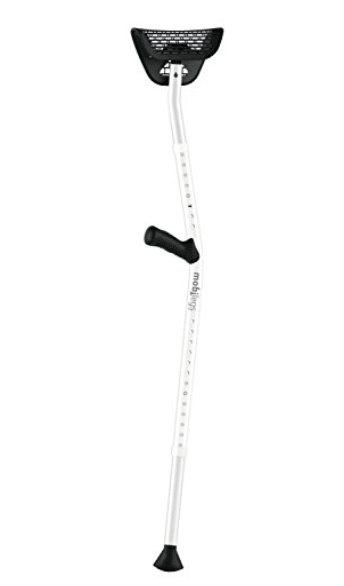
These crutches can be adjusted for use with different body types and can be fitted to approximately 98 percent of adults ( 4’9” to 6’4” up to 300lbs).
They are also designed with ergonomic handgrips to maintain a natural wrist angle that evenly distributes the weight throughout the palm.
Price: $150
Millennial Crutches
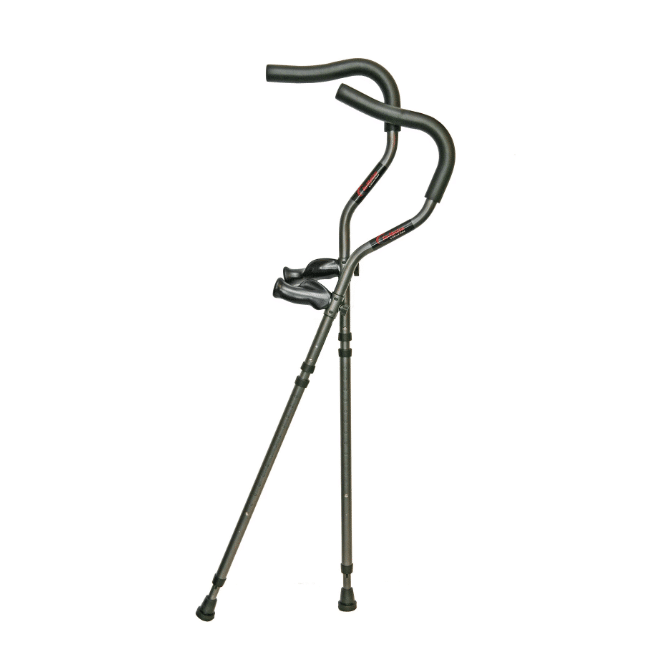
These crutches are equipped with adjustable handles intended to keep hands and wrists in their natural position, to reduce the risk of developing carpal tunnel for its users.
They are suitable for both adults and children but are only intended to be used as a short-term crutch (no more than four weeks).
Some models have a shock-absorbing underarm section to alleviate the pain and potential axillary nerve damage of standard underarm crutches
Price: $50 – $150
Strutters
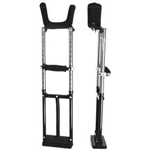
Strutter crutches are a type of axillary crutch that feature an armrest and hand grip. They are unique because they are spring loaded. They move with your body and have a longer foot for better stability.
Strutter crutches offer a more even weight distribution under the arms. This helps reduce the potential for nerve damage. They can be used by people with poor leg strength. The cons are that they’re not truly hands-free and can limit mobility.
The pros of this type of crutch are that they offer a more even weight distribution under the arms. This helps reduce the potential for nerve damage and can be used by people with poor leg strength. The cons are that they are not truly hands-free and can limit mobility.
How to Use: Strutters are used in the same manner as underarm crutches but provide greater stability.
Gutter Crutches (Platform Crutches)
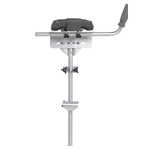
These outdated crutches were originally designed for patients with both a partial weight-bearing injury and an impaired grip. Sometimes known as arthritic crutches or forearm crutches, their signature feature is a padded forearm support made of metal, a strap, and an adjustable hand grip.
The forearm padding allows the user to distribute their weight across a greater surface area, relieving the pressure on their hand grip. This is especially useful for those with Rheumatoid disease. However, with new technology such as the iWalk crutch, this style of crutch is rarely used today.
Strutters
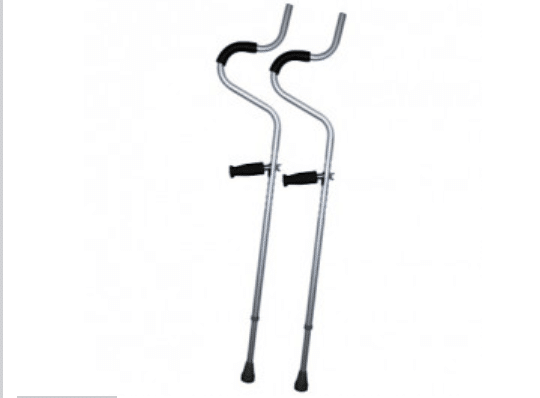
Hope crutches are designed to be safer and more stable crutches compared to the conventional underarm model and accommodate adults between 5′ 2″ and 6′ 8.”
They also have flexible height and handgrip adjustments to create a custom fit for each user.
Price: $150
How Do I Choose the Right Crutches?
The Basics
Not all crutches are created equal. When choosing, consider what type of injury or illness you have and how much mobility you want during your recovery.
Below is a comparison of the main types of crutches.
Mobility
All types of crutches will help you move around during your recovery period.
Underarm, forearm, and strutter crutches function similarly. They enable you to move about and go up and down stairs. But they are tiring so you may find that you can’t go too far. They also take away the use of your arms and hands to get around. This can be incredibly inconvenient if you need to carry, well, anything.
Knee scooters can help you get around fairly quickly. They are brilliant for zipping around on flat surfaces. But they aren’t suitable for going up and down stairs or uneven terrain.
A hands-free crutch like the iWALK Crutch, wins on mobility. It will enable you to move around like you did before your injury.
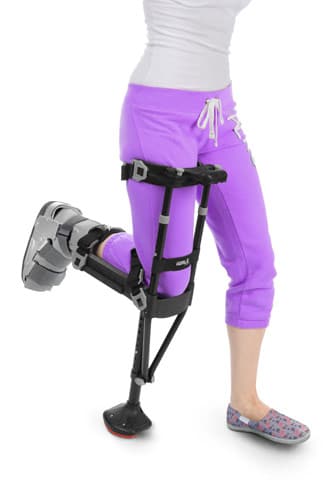
Ease of Use
Every crutch requires some practice before you can use it. You can usually start using traditional crutches, like forearm and underarm, immediately. However, it’s important that you fit and use them properly otherwise they could cause further problems.
The iWALK Crutch takes a little more time to fit. These instruction videos show you how to assemble and use one. Most people learn to use it after about 20 minutes of practice.
Once you’re up and about, you’ll find that conventional crutches are tricky to use while performing daily tasks. Even making a cup of coffee can be a challenge.
Knee scooters are better for getting about but still require the use of your hands. Hands-free crutches offer the greatest ease of use when it comes to keeping up with daily tasks.
Pain Free
Underarm crutches are the worst culprits and can cause incredible underarm pain and even nerve damage. Forearm crutches place more pressure on your hands which can create soreness there as well.
Some of the best pain-free options include knee scooters and hands-free crutches. These designs keep weight off your arms, hands, and underarms.
How To Use Crutches
Have you ever asked someone how easy it is to walk on crutches?
Let’s face it, crutches suck.
If you are like millions of people every year who find themselves diagnosed with a lower leg injury, you may find yourself required to be non-weight bearing, and crutches may just be one of the mobility options suggested.
Maybe you had the misfortune of tearing your achilles tendon while playing basketball, undergoing surgery for Plantar Fasciitis, or simply spraining your ankle when stepping off a curb. Any of these common injuries can be non-weight bearing, and can lead to having to learn how to use the most hated device you will ever use – underarm crutches.

Let us help you with the following pointers on how to walk with crutches, and afterwards, we will offer you another crutch option that you may not have been aware of.
When learning how to use crutches, it is important to remember that they require balance, dexterity, upper body strength, and the use of both hands. It will undoubtedly take practice to master and we highly recommend you practice in a large, open area with even ground, as obstacles such as uneven terrain, or having to navigate in small spaces, will greatly impede your progress [10]. Once you have it down, and are learning how to walk with non-weight bearing crutches, you will still be severely limited in your ability to perform daily activities, but you will never forget how to use them.
Here are some tips to get you going as quick as possible.
Step 1: Getting Started
A) Make sure that your crutches are adjusted properly for your height. It can help to choose one pair of shoes to wear during your recovery and make the height adjustment to your crutches while wearing them. Wearing differently soled shoes during this time means you’ll need to readjust the crutches accordingly.
B) Adjust the height so that the top of the crutch is positioned under your arm, but approximately 1.5 – 2 inches below your armpit. Avoid jamming the crutches into your armpits. Your weight should be concentrated on your hands and the handgrips. Avoid letting your shoulders carry any of the weight, as this can cause shoulder pain.
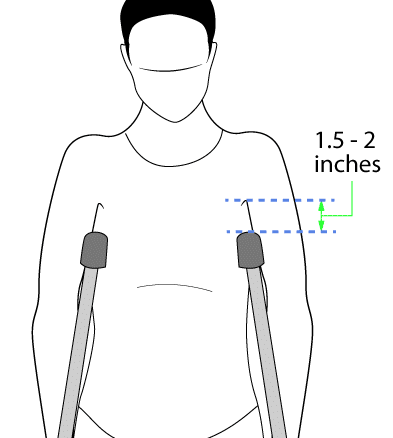
C) After you get the height correctly adjusted, stand naturally and adjust the handgrips to allow for a 15-degree bend in the elbow.
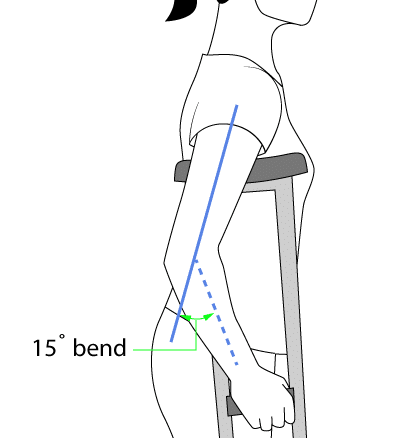
Step 2 – Using Your Crutches
D) Standing on your uninjured foot with your injured foot up, place both crutch tips on the ground in front of you, slightly more than hip width apart, and approximately 12 inches in front of your good foot. The longer your legs, the longer your stride.
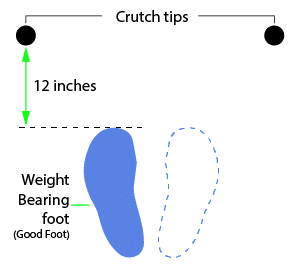
E) Gripping the hand grips, swing your body forward, leaning on your crutches for support.
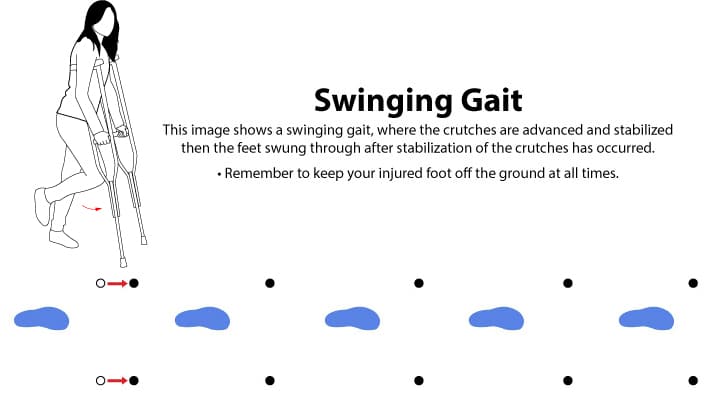
F) Let your entire weight be supported by the non-weight bearing crutches as you lift your uninjured foot and place it one single step in front of the resting crutch tips. The distance should be short enough that you feel stable, about 12 inches. Remember to keep your injured foot off the ground at all times.
G) Repeat the process.
Additional Tips
For optimal performance, your weight should be concentrated on your hands and the handgrips. Also, avoid letting your shoulders carry any of the weight, this can lead to shoulder pain.
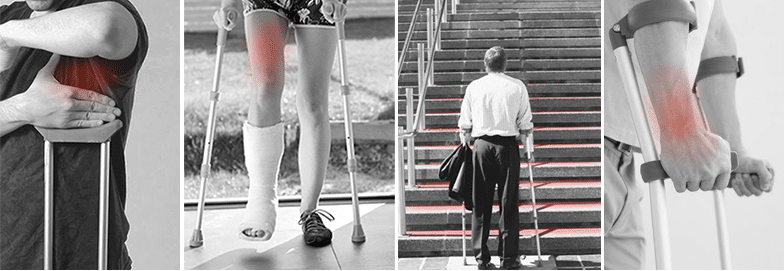
Though learning to master the art of walking with crutches can be difficult, it is necessary if you choose underarm or forearm crutches. There are many things to consider with these types of crutches such as “How do you walk on stairs with crutches?” or “How do you carry things with crutches?”. Research questions like these before you attempt any tasks on crutches. It is essential to protect your injured leg by using crutches properly. When people ‘cheat’ on their doctor’s orders to be non-weight bearing, they increase the risk of re-injury and extended recovery times.
History of Crutches
Crutches have been around for thousands of years. Our ancestors who were living with polio, leprosy and many other illnesses and injuries used them to get around.
The earliest known images of crutches date back to the New Kingdom period of ancient Egypt, around 1500 B.C. They were basically sticks that were modified to provide support while walking.
Crutches evolved over the years until the start of the Middle Ages. The crutches used during Medieval times look a lot like our crutches today, minus the hand grip. It was after this period that crutch innovation essentially came to a standstill. The history of crutches remained virtually unchanged until the 20th century.
The first commercially manufactured crutches are attributed to Emile Schlick in 1917. The first adjustable crutches were created by A.R. Loftstrand Jr. a few years later. Forearm crutches weren’t invented until the 1950s, by Thomas Fetterman, a polio survivor who created them to improve his mobility.
These days, 10 million pairs of crutches are sold each year in the US alone and the country’s crutch market is thought to be worth more than $300 million dollars.

Frequently Asked Questions for Crutch Users
How Do Crutches Work?
Crutches are meant to help you keep weight off your affected or injured leg so you can still move around while you heal. Correctly using your crutches takes practice, but understanding how they work and following the general techniques for using crutches will help you adjust to your time on crutches more easily and make your crutches more comfortable to use.
Crutches work by using your arms to support the weight of your lower body so you can keep weight off any injured or affected limbs. Crutches only work if one of your legs is injured and the other is able to support your body weight. This is because your uninjured leg will be required to carry most of your weight. It’s also important to understand that your body weight should not be supported by your underarms. If you rely on your underarms for support, you may end up with nerve damage from putting too much pressure on the area.
The correct method of using crutches involves standing up straight with your crutch tips two to three inches in front of your feet and adjusting your crutches so the top pad falls around one inch below your armpits. As you prepare to move with your crutches, your hands should be on the hand grips with a slight bend in the elbow and no bend in your wrist. Place the crutch tips in front of your toes and practice gently swinging your body through your crutches to move. You should keep the knee of your injured leg bent as you swing your body to prevent it from touching the ground, and land on your uninjured leg.
While it will take a little practice to get the hang of your crutches, learning to use them correctly will keep you more comfortable while you recover and help you get around more efficiently.
What Is the Purpose of Crutches?
Crutches are designed to help keep weight off your injured foot or leg and help you maintain mobility while you recover. To correctly use crutches, you need to make sure that you’re using them correctly and keeping all weight off of your injured leg.
Different crutches can be used to assist with different types of injuries. Traditional crutches and forearm crutches work for individuals who have good upper-body strength and leg injuries ranging from the hip to the foot. Other crutches such as knee scooters and knee crutches are ideal for individuals who have below-the-knee injuries.
Do People Still Use Crutches?
People all over the world and throughout history have used crutches and continue to do so to help them stay mobile during recovery.
Injured people of Ancient Egypt and the Middle Ages have been depicted using crutches that look much the same as the ones we use today. These historical crutches used a long pole or stick and often had a top that could be used to support weight.
Today, crutches offer greater comfort, safety, and are easier to use than they were in the past. Modern crutches feature better grips, additional padding for comfort, and construction for lightweight materials for easier transportation. Other crutches allow you to bend your knees and provide support that way, while still others use your forearms to help you get from place to place.
When Do I Stop Using Crutches?
Because using crutches can be difficult and inconvenient, you may wonder when you can stop using your crutches.
No matter how much you may want to stop using your crutches, it’s important to continue to use them until your healthcare provider tells you you can stop.
Your doctor will give you discharge instructions so you know how to use your crutches, how long you should be on crutches, and when you can stop using them. In general, different injuries require different amounts of time to ensure proper healing. Sprained ankles usually require approximately two weeks to one month of recovery time, broken bones take an average of six weeks, and torn or ruptured ligaments can take as much as six months of recovery time.
While these time frames are the average, you should always heed the advice of your doctor regarding how long you should continue to use your crutches. If you’ve recently had an injury or surgery, your doctor will likely schedule a followup appointment with you to review your healing progress and provide updated recommendations for when you can stop using crutches.
Does Using Crutches Build Muscle?
Using traditional crutches requires the use of your upper body strength. As with any exercise that requires exertion, using your crutches will build and strengthen some of your muscles, especially in your arms and torso. However, using traditional axillary crutches is not an ideal method of building muscle because it can cause pain and nerve damage in your arms, and pain in your wrists.
Incorrectly using crutches or using crutches for long periods of time can lead to nerve damage, which is why you should only use crutches if you actually need them and have been recommended to use crutches by your doctor.
Do Crutches Hurt?
Traditional forearm or axillary crutches aren’t well-known for being comfortable. Prolonged use of crutches often causes soreness in the arms and can even cause considerable discomfort and pain to your underarms, hands, shoulders, and forearms. If used incorrectly or for long periods of time, underarm crutches can even cause permanent nerve damage in your underarms. This is because using crutches incorrectly and placing pressure on your armpits places pressure directly on your radial nerve and pushes it up against your humerus.
Make sure you’re following your doctor’s instructions on how to correctly use your crutches to avoid unnecessary pain and possible nerve damage.
Does a Sprained Ankle Need Crutches?
Because using crutches can be difficult and inconvenient, you may wonder when you can stop using your crutches.
No matter how much you may want to stop using your crutches, it’s important to continue to use them until your healthcare provider tells you you can stop.
Your doctor will give you discharge instructions so you know how to use your crutches, how long you should be on crutches, and when you can stop using them. In general, different injuries require different amounts of time to ensure proper healing. Sprained ankles usually require approximately two weeks to one month of recovery time, broken bones take an average of six weeks, and torn or ruptured ligaments can take as much as six months of recovery time.
While these time frames are the average, you should always heed the advice of your doctor regarding how long you should continue to use your crutches. If you’ve recently had an injury or surgery, your doctor will likely schedule a followup appointment with you to review your healing progress and provide updated recommendations for when you can stop using crutches.

